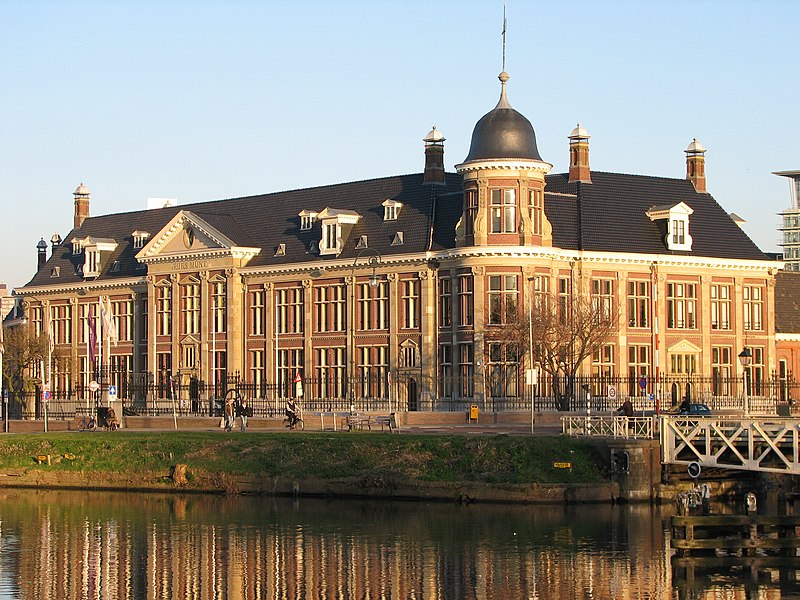Koninklijk Muntenhuis – Will It Stay? Posted by Sten on Feb 1, 2016 in Culture
Every country has a currency, and so every country needs a place where that money is made. In the Netherlands, coins are made by a company called Koninklijke Nederlandse Munt (KNM) or the Koninklijk Muntenhuis. Paper bills are made elsewhere. Despite this important role, the KNM might become superfluous very soon… So let’s have a closer look. Where does KNM come from? And what does it do today? And why might it be superfluous?
What Is KNM? – A Short History

Koninklijke Nederlandse Munt in Utrecht. If you look closely on the Gevel (facade) on the left side of the building, you can still find the engraving of its name from 1814: ‘s Rijks Munt (Coin of the Realm) (click on the picture to enlarge it).
Napoleon established KNM when he reigned in the Netherlands. In the early 19th century, major Dutch cities had their own currency, and thus their own coin minter. This led to a terrible administrative fuzz, because every other city you would visit had another currency. In 1806, Napoleon decided to stop this practice and created KNM by royal decree: a national coin, that was to apply to the entire country. Nobody objected to that… Since the coin minter in Utrecht was the best equipped, which already existed since 1567, by the way, it became the seat of KNM.
After the downfall of Napoleon, the Netherlands became a Monarchy in 1814. KNM changed its name into ‘s Rijks Munt, which is still visible on the building today (see the picture).
All this time, the company stayed private. Only in 1902, it came under the control of the Ministerie van Financiën (Ministry of Finances – the Dutch Treasury). In 1912, it was officially made a public company. In 1994, it became a private company again, however with the Dutch Government as the only shareholder. Its focus shifted now more on the coin minting market, instead of only on the production of Dutch coins.
What does KNM do?
KNM is responsible for the production of the Dutch euromunten (euro coins). Since the introduction of the euro, KNM made 2,8 billion euro – six times more than they did when producing the gulden, the former Dutch currency.
KNM also produces special coins, like those for special events or coin collectors.
Lastly, KNM is also involved in the production of other currencies. It is a private for-profit company, so it can take on orders from other countries, for example, that wish to have their coins produced. And that almost cost KNM its head…
Why KNM Is No Longer Needed – What’s Going On Today?
First of all, the problem with producing coins is that they last for decades. So once sufficient coins are produced, the job is done for a long time. So there is not a lot of business in the coin minting industry.
On top of that, a few months ago, KNM had issues with an order from Chile. The South American country ordered 850 million pesos. Because of this huge amount of coins, KNM put a new machine to work. However, this machine did not work properly, and the employees of KNM ended up counting the coins by hand.
They sent out the order to Chile, but Chile was not happy with the result – the quality of the coins was insufficient. This led to a huge fine for KNM, which basically rendered the company bankrupt.
However, since it is factually a state-owned company, it will not go broke because of that. The Dutch State decided to keep it intact. This seems to be more related to history and tradition, rather than the importance of the company itself. The mould for the Dutch euro coins could easily be sent to another company like KNM that could produce the Dutch coins.
I think it is a good idea to keep a 450 years-old business intact, with a national history like the KNM. Maybe they should just change their business model?

Build vocabulary, practice pronunciation, and more with Transparent Language Online. Available anytime, anywhere, on any device.
About the Author: Sten
Hi! I am Sten, both Dutch and German. For many years, I've written for the German and the Dutch blogs with a passion for everything related to language and culture. It's fascinating to reflect on my own culture, and in the process allow our readers to learn more about it! Besides blogging, I am a German-Dutch-English translator, animator and filmmaker.




